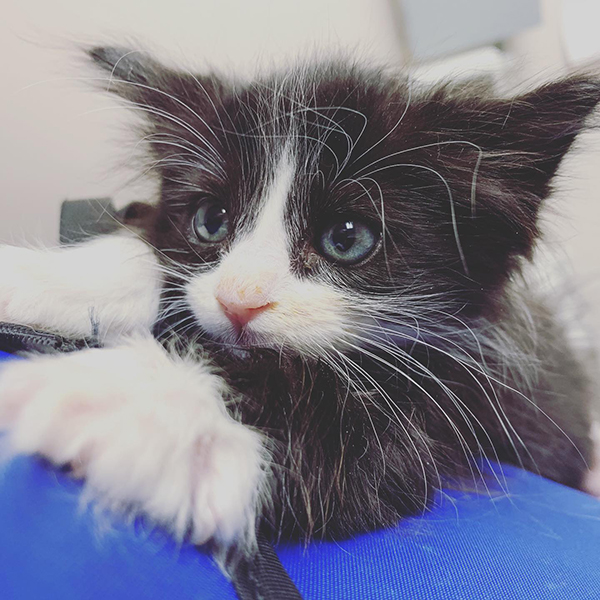Vaccines protect our pets from contagious and potentially fatal diseases. At CoastView Veterinary Hospital, your pet can receive vaccinations for dogs and cats and still LOVE going to see their favorite veterinarian. Ensuring that your pet has a Fear Free experience every time they visit our hospital is our priority. See how we make this possible by visiting our Fear Free Vaccine Blog.
Vaccinations for dogs and cats that require a booster in the series must not be administered more than 6 weeks apart. If the booster vaccine is administered after 6 weeks, the series will need to be restarted.
Vaccination Schedule for Dogs and Puppies:

Puppies:
All puppies will receive a DAP series beginning around 6-8 weeks continuing through 16-20 weeks. We booster these vaccines because the puppies are no longer getting antibodies through their mother’s milk and are not capable of building a defense to diseases until they are at least 16 weeks of age. At-risk puppies will receive two Lepto vaccines at 12 and 16 weeks. Lepto can be given as early as 6 weeks of age. Puppies will also receive a rabies vaccine ideally between 12 and 16 weeks of age.
- DAP (Canine distemper, adenovirus, and parvovirus): begin as early as 6 weeks, booster at 3-4-week intervals through 16 weeks of age
- Lepto (for at risk patients): Begin at 12 weeks of age and give a second vaccine at 16 weeks
- Rabies is given at 12 to 16 weeks
- Bordetella (kennel cough): can be given at 8 weeks
- Canine Influenza (CIV) – Can be started in healthy dogs at 7 weeks of age or older. A second dose is given 2 to 4 weeks later. A minimum of two doses is required for primary immunization. If more than 6 weeks has passed since the initial dose, the series of two doses must be restarted.
First-year booster:
- All dogs should receive DAP, Rabies, Bordetella, Lepto, and Canine Influenza (if administered on schedule during puppyhood).
Adult Dogs
- Booster DAP and Rabies Vaccines at 1 year of age and then every three years thereafter
- Booster Lepto (for dogs at high risk) annually
- Booster Bordetella annually
- Booster Canine Influenza annually
- Rattlesnake: After the first vaccination the dog should receive a booster approximately one month/4 weeks later, followed by annual (11-month interval) boosters. The vaccine’s protective effect is most evident four to six weeks after vaccination and declines over time. Dogs that are exposed to rattlesnakes for more than six months of the year may require boosters twice a year. The most recommended time of year would be in the spring before peak rattlesnake season.
Vaccine Details
DAP
CoastView carries a 0.5 mL vaccine that provides protection against distemper, adenovirus type 1 (hepatitis), and parvovirus in one formula. Puppies that are affected by any one of these diseases may exhibit gastrointestinal upset, respiratory distress, and loss of neurological function. These diseases are extremely contagious to other puppies and can spread quickly within an unvaccinated population. Untreated, these diseases require hospitalization, nutritional support, and may prove fatal despite aggressive treatment. This vaccine is given to puppies at 8, 12, and 16 weeks of age. We booster the DAP 1 year after the puppy series is complete and then is given every 3 years thereafter.
Lepto
Leptospirosis is a bacterial disease that affects humans and animals. In addition to Lepto being transmitted in wildlife urine, there have been cases linked to reclaimed water systems. Lepto causes renal failure in mammals and may be fatal if left untreated. Our Leptospirosis vaccine is shown to be effective against four types of Leptospirosis. Lepto is given at 12 and 16 weeks of age in puppies and is boostered annually in adult dogs.
Bordetella Bronchiseptica
Often referred to as kennel cough, Bordetella Bronchiseptica is an upper respiratory virus that can infect all dogs. Bordetella has the potential to progress into pneumonia when left untreated. Dogs who frequent daycare facilities and outdoor off-leash dog areas may be encouraged to receive the vaccine every 6 months. Annual vaccination is recommended for indoor dogs even if their social interaction with other dogs is limited. This vaccine is given around 8 weeks of age in puppies and boostered every 6-12 months, dependent on individual exposure.
Rabies
Rabies virus is transmitted through the saliva of an infected mammal. Transmission typically results from a bite wound. Rabies is zoonotic and therefore humans are at risk for contracting this virus. Rabies spreads through the infected individual via the spinal cord and brain. Neurological function will deteriorate resulting in death. In California a Rabies vaccine is required by law for dogs. The first vaccine is given between 12 and 16 weeks of age and is boostered 1 year later. Thereafter, this vaccine is required every 3 years in the state of California. These requirements are specific to the state the pet resides in.
Rattlesnake
A Rattlesnake bite to a dog can be fatal if not treated immediately with emergency care. This vaccine is given to dogs who are at risk for coming in contact with a Rattlesnake. The vaccine reduces the intensity of the reaction from the Rattlesnake bite. Dogs who have been vaccinated still require emergency treatment but often respond to fewer vials of anti-venom. This vaccine requires two to three initial vaccines boostered 4 weeks apart. Once the initial series is complete the vaccine must be boostered annually. Rattlesnake vaccine is not to be given at the same time as other vaccines to reduce the risk of a vaccine reaction. You may give another vaccine to the pet as long as 24 hours has passed from when the rattlesnake vaccine was given.
Influenza
Canine Influenza is a respiratory disease. Symptoms include sneezing, coughing, fever, and lethargy. Dogs in shelter environments, boarding facilities, or attend dog day care may benefit from this vaccine. The initial vaccine series requires 2 vaccines spaced 2-4 weeks apart. The vaccine is boostered annually thereafter.
- There are several factors that determine a pet’s need for vaccines including –
- Age
- Exposure
- Risk
- It is imperative for puppies to receive vaccines at the appropriate intervals. Puppies typically receive vaccines at 8 weeks, 12 weeks, and 16 weeks of age.
- Vaccine Titers are available for clients who elect to decline the recommended vaccines. However titers are not a guarantee that the pet cannot contract the disease. Titers are not available for every disease for which vaccines are recommended.
- A Rabies Titer is not a substitute for a Rabies Vaccine and will not be accepted by the County of San Diego.
- Unvaccinated dogs risk the health and safety of other dogs, especially vulnerable populations of dogs like puppies.
- Unvaccinated dogs risk the health and safety of humans if the disease has zoonotic potential.
- We always invite clients to discuss the appropriate vaccine protocol for your pet with one of our Coastview veterinarians.
Vaccination Schedule for Cats and Kittens:
All feline vaccines are inactivated/killed.
- FVRCP: begin as early as 6 weeks, booster at 3-4-week intervals through 16-20 weeks of age
- FeLV: begin as early as 8 weeks when in combination with FVRCP and as early as 10 weeks by itself; with another booster at 3-4-week interval
- Rabies can be given 12 weeks or older and may be recommended for some indoor cats
- Booster FVRCP, FeLV, and RV in one year
- Booster FVRCP every 3 years from this point forward
Follow same instructions as for indoor kitten series.
- FVRCP recommended every 3 years for adults
- FeLV recommended every year for adults
- Rabies is recommended every 3 years
- All kittens will receive a FVRCP series beginning around 6-8 weeks continuing through 16-20 weeks. We booster these vaccines because the kittens are no longer getting mom’s antibodies in mild and are not capable of building a defense to diseases until they are around 20 weeks.
- All kittens will have a FELV / FIV test performed to ensure they are negative
- All kittens will receive two FELV vaccines at 8 and 12 weeks given that an FELV test is Negative.
- Kittens may also receive a rabies vaccine if they are at risk at 12 weeks of age
First-year boosters:
- All cats will receive FVRCP and FELV. If they are at risk, Rabies will also be given.
Vaccine Details
FVRCP
The FVRCP vaccine protects against Feline herpesvirus (viral rhinotracheitis), Calicivirus, and Panleukopenia. Symptoms of these diseases include respiratory distress, ocular discharge, oral ulcers, and gastrointestinal disease. These diseases can spread to other cats. If left untreated the cat can develop complications resulting in hospitalization and intensive supportive care. These diseases are not zoonotic and do not pose a risk to humans. The FVRCP vaccine is ideally given to kittens at 8 weeks, 12 weeks, and 16 weeks of age. Cats who reside in shelter environments may receive FVRCP vaccines before 8 weeks of age since they are at a higher risk. This vaccine is boostered 1 year after the kitten series is complete and every 3 years for adult cats.
FELV
The FELV vaccine protects against the Feline Leukemia virus. The prognosis is poor for cats who have contracted this virus. The virus is spread through blood and bodily fluids. Cats who groom, share food and water bowls, or fight with one and others are at risk to transmit the disease. It is typically recommended that your cat is tested for this disease as a kitten and annually if your cat goes outdoors. If your cat tests negative it is safe to allow your cat to interact with other cats. If your cat tests positive it is imperative that your cat is separated from other cats to avoid spread of the disease. This vaccine is given at 12 weeks and 16 weeks of age in kittens. It is boostered annually in adult cats. If your cat is exclusively indoor and there is no exposure to other cats where their FELV status is unknown your veterinarian will assess if there is a need to continue to vaccinate your cat for this disease.
Rabies
Rabies virus is transmitted through the saliva of an infected mammal. Transmission typically results from a bite wound. Rabies is zoonotic and therefore humans are at risk for contracting this virus. Rabies spreads through the infected individual via the spinal cord and brain. Neurological function will deteriorate resulting in death. The first vaccine is given between 12 and 16 weeks of age and is boostered 1 year later. These vaccinations for dogs and cats are boostered every 3 years.
Check us out on Facebook!








